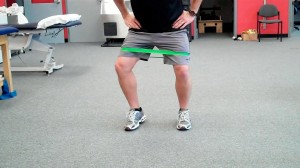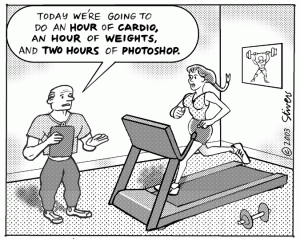Brian Schiff’s Blog
Injury Prevention, Sports Rehab & Performance Training Expert
Unearthing the cause of anterior knee pain and ridding our patients and clients of it is one of the never ending searches for the “Holy Grail” we participate in throughout training and rehab circles. I honestly believe we will never find one right answer or simple solution. However, I do think we continue to gain a better understanding of just how linked and complex the body really is when it comes to the manifestation of knee pain and movement compensations.
We used to say rehab and train the knee if the knee hurts. It was simply strengthen the VMO and stretch the hamstrings, calves and IT Band. Slowly, we began looking to the hip as well as the foot and ankle as culprits in the onset of anterior knee pain. The idea of the ankle and hip joint needing more mobility to give the knee its desired level of stability has risen up and seems to have good traction these days.
Likewise, therapists and trainers have known for some time that weak hip abductors play into increased femoral internal rotation and adduction thereby exposing the knee to harmful valgus loading. So, clam shells, band exercises and leg raises have been implemented to programs across the board.

Single Leg Resisted Hip External Rotation
As a former athlete who has tried his hand at running over the past 5 years, I have increasingly studied, practiced and analyzed the use and importance of single leg training and its impact on my performance and injuries. As I dive deeper into this paradigm, I continue to believe and see the benefits of this training methodology for all of my athletes (not just runners).
As a therapist and strength coach, it is my job to assess movement, define asymmetries and correct faulty neuromuscular movement patterns. To that end, I have developed my own assessments, taken the FMS course, and increasingly observed single leg strength, mobility, stability and power in the clients I serve. Invariably, I always find imbalances – some small and some large ones.
What are some of the most common issues I see?
In most gyms and training circles, people are performing bench press or push-up exercises. There is no doubt in my mind that repetitive heavy full range bench press causes many of the labral and cuff injuries among males I have seen over the years These injuries are often the attritional type – developing over many months and years.
What about push-ups? Is the force development pattern the same? Are they safer? Honestly, I believe in keeping the elbow at a point at which it does not drop below the plane of the body (bench press) or move above the body (push-up). Essentially that means keeping to a 90 degree angle or less. Why? Well, regardless of load, I feel the real risk is not so much in the motion itself but the very repetitive manner in which it occurs with external loads, often lending itself to acquired anterior shoulder laxity, strain on the proximal biceps anchor (think SLAP lesions) and secondary shoulder impingement. The picture below hurts my shoulders just looking at it, and over time this technique will hurt your shoulders too.

But, I say all that to set up today’s post. In a recent article in the February edition of the Journal of Strength & Conditioning Research, David Suprak et al. looked at the effect of position on the % of body mass supported during traditional and modified push-ups.
The study looked at 4 static positions in 28 males (about 34 years old) who were highly trained and members of the special forces or SWAT team (the up and down position for regular and modified push-ups) to determine the change in body mass (BM) supported by the upper body in different ranges of motion. The down positions studied were at approximately 90 degrees (the lowest depth I safely recommend) and all holds were performed for 6 seconds.


I think most people involved in health and fitness are up to speed on the move to address mobility and stability at the hip as an integral part of our assessments and exercise prescription. I know in my practice I see lots of issues with both a lack of hip stability and mobility.
As I learn, practice and evolve as a professional, I find myself looking for more bang for my buck with exercises. A few themes and trends in my own training include:
- Increasing emphasis on body weight exercises
- More and more single leg training
- Integrated movement patterns versus isolation
So, if you are familiar with Gray Cook and Mike Boyle (I am specifically referring to their writing and discussion on the joint by joint approach) you know that they advocate for increasing mobility at some joints and gaining stability at others. Ironically, the hip has a need for more of both depending on the movement and individual imbalances.
So, I really enjoy exercises that provide some of each and meet the trends I referenced above. I just released one such hip exercise in my “Functionally Fit” Column in PFP Magazine. I call it the RDL Hip Driver.


Click here to read the entire post with a full description of how to perform the exercise and its functional application.
Today’s blog post is about an observation and fundamental tenet of my practice today as a sports physical therapist and fitness professional. Having been in the business of rehabbing and training the human body for 15 years, I feel qualified to say I know a thing or two about training and exercise.
Perhaps one of the greatest pearls I can pass along as it relates to being a health and fitness professional involves the art of teaching. You see, I have witnessed firsthand the desire people have to attain knowledge when it comes to their bodies. Just look at how quickly and often people take the web in search of answers from the latest ab workout to the source of and remedy to their every ache and pain.
We live in a society of information overload. Unfortunately, the web, YouTube, FB, Twitter and so on give just about anyone a stage to philosophize and sound off as an “expert.” Many people who claim to know how to “train” you for this and that have little to no real world experience doing it, nor do they possess enough pre-requesite knowledge to truly be considered an expert.

I find many people mistakenly look for what they perceive to be the most “in” or “intense” training they can find, as they believe this is the way to finally meet their goals. In reality, what they should be seeking is someone interested in teaching them how to better understand their own body and how to apply the proper training principles to it in order to bring about the desired result they are so desperately seeking.
Training typically involves putting together drills, workouts or routines to challenge clients physically. Teaching, on the other hand, is centered on educating clients how to listen to their bodies and use that feedback to appropriately adjust physical loads and exercise programming to avoid injury and make positive physical adaptations.
In my last post, I shared some practical plyometric drills with you to help teach proper landing mechanics in an effort to reduce ACL injuries. Yesterday, I presented my comprehensive approach to knee training at our ACL Symposium in Cary, NC.

One of the fundamental errors I see coaches and athletes make is abandoning their pre-season training efforts during the in-season. While athletes need to spend the majority of the in-season focusing on sports skills, they must also maintain the neuromuscular training adaptations acquired in the off-season and pre-season.
In my mind, the phrase “use it or lose it” is applicable for the neuromuscular training effects we see with balance, strength, agility and plyometric training. This is especially true for our high risk female athletes like soccer and basketball players who suffer knee sprains, ACL tears and patellofemoral pain at disproportionate rates.
I often hear coaches say, ” I don’t have time to get workouts done and still accomplish what needs to be done at practice.” While, time management may be difficult, I think coaches could probably squeeze in a single training session lasting 15-20 minutes if they simply knew how important it was to the overall health and performance capacity of their team.
With that said, I like to offer simple, yet effective exercises that can be done on a court or field with the whole team simultaneously without the need for expensive equipment. Exercises should focus on activating the glutes (including the medius and minimus) as well as training the hamstrings more since most female athletes tend to be quad dominant.
These exercises are just as effective for males too. So, in the video below I will reveal some exercises I prefer to do to increase strength and reduce injury risk. Perform 2-3 sets of 8-15 reps focusing on strict form throughout.

